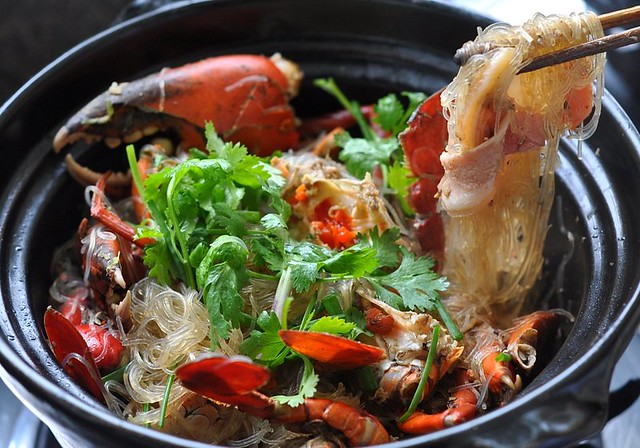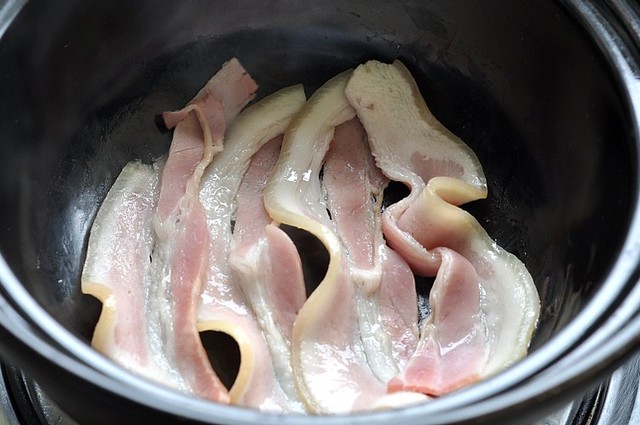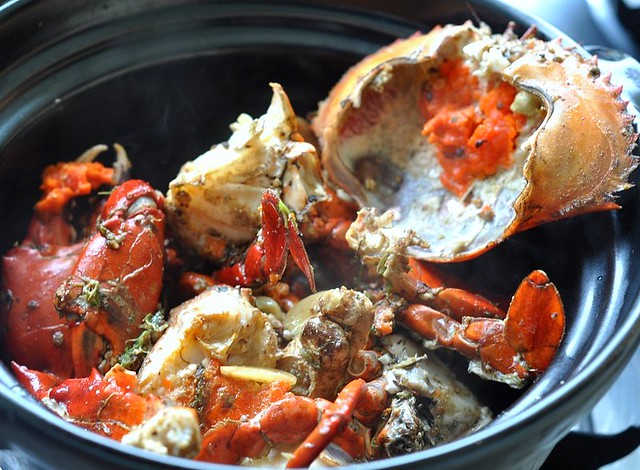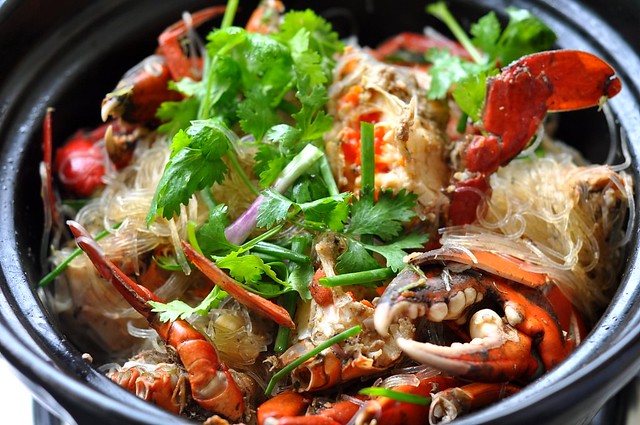
This is a dish that we always order whenever we eat Thai food anywhere but KK. That's because there are hardly any Thai restaurants in KK and the few that claim to be never have this dish on their menu. Wey, who doesn't like seafood, loves this dish after tasting it in Bangkok but that's because he only wants the fatty pork strips at the bottom of the pot.
I've made this dish several times but the flavor and taste somehow just didn't measure up to what I've tasted in Awana Hotel Singapore. Recently Wey asked for the dish again and I spent an hour searching for the recipe on the net, weeding out the ones that didn't read tasty enough. I finally settled on the recipe from here. I'm glad I did because the whole family gave two thumbs up for the dish. I've made some changes to the ingredients (used Maggi sauce as recommended by Appon, pounded the coriander stems into a paste for stronger flavor) but the biggest change is in the cooking of the crabs. Instead of frying the crabs in the clay pot, I stir-fried them separately in a wok because I find that unless you get your clay pot heated very well, the crabs don't get that stir-fried flavor. I think that's why many restaurants in Thailand use thin metal pans rather than clay pots for this dish. Frying the crabs also shrinks them so that they fit better into my clay pot.
This dish, btw, is called poo ob woon sen. Poo (that's right, poo, not phoo) is crabs in Thai, ob is to simmer and fry (sort of) and woon sen is glass noodles, so-called because they are clear as glass. Russell Peters was right. Asian languages are hilarious.
Teamed with a soup, poo ob woon sen can make a substantial meal. Squeeze some lime juice and sprinkle on some bird's eyes chilies on the noodles and tackle the crabs with your fingers. Yum.



Clay Pot Crabs With Glass Noodles
1 kg live crabs (or lobster or prawns)
1 T butter
7 cloves garlic, peeled and sliced in half lengthwise
4 slices bacon
5 to 6 fresh whole coriander/cilantro plants, roots intact
3 slices ginger
1 t (1/2 t if you don't like the heat) white peppercorns, pounded coarsely
250 g glass noodles* (mung bean noodles), soaked in cold water at least 15 minutes
1 T light soy sauce
2 T fish sauce
Stock:
2 1/2 cups chicken stock
3 T oyster sauce
1 T Maggi soy sauce
1 T fish sauce
2 t sesame oil
1 (or 2) t brandy or whiskey
1 1/2 t caster sugar
garnish: coriander leaves, spring onions and lime wedges
*get the type that doesn't break easily upon cooking. In KK, myXo Green Bean Vermicelli from wet markets is the best.
1. Mix all the stock ingredients in a bowl. Set aside. Separate the coriander into 3: the roots hairs, the main root and stems, and the leaves. Using a pestle and mortar, pound the main roots and stems into a paste. Scrub the crabs well, cut into big pieces, drain very well and toss with 1 T of the fish sauce.
2. Put the bacon into the unheated clay pot and then turn the heat on, medium low.
3. Meantime, heat up a wok or frying pan. Add the butter and fry the garlic until golden. Add the coriander root hairs, coriander stem-root paste, ginger and peppercorns and fry a couple of seconds before adding the crabs. Add 1/4 cup of water, 1 T light soy sauce and the remaining 1 T of fish sauce. Cover the wok and simmer a couple of minutes until crabs are cooked & the liquid has dried up. Transfer the crabs into the pot.
Alternatively, you can do step 3 in the clay pot. This is how it's normally done but I prefer to give the crabs a good fry to get a better flavor.
4. Add the glass noodles to the pot and pour the sauce over, stirring well to mix. Do not disturb the bacon though; leave them in the bottom of the pot. Cover and let simmer about 5 minutes. Taste and season. Switch off the heat. I find that this lets the noodles soak up the liquid and flavor better.
If you add the uncooked crabs to the clay pot, let it cook until it's almost done before adding the noodles.
5. When ready to serve, heat up the pot and add a little bit more stock or water if necessary. Garnish with coriander leaves and spring onions.
No comments:
Post a Comment